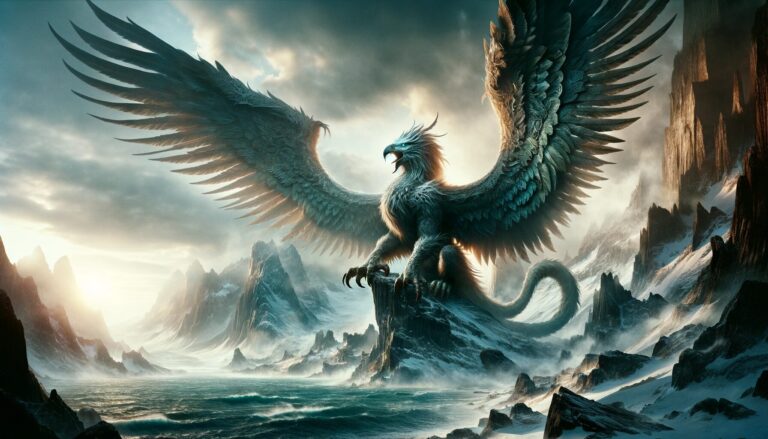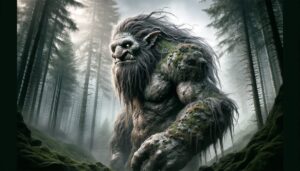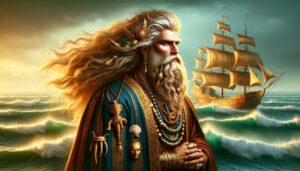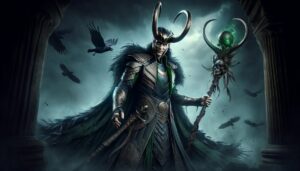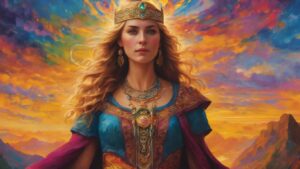Table of Contents
In the ancient realms of Norse mythology, amidst the thunderous clash of gods, giants, and mythical beings, there exists a towering figure of immense power and enigmatic presence – Hraesvelgr, the colossal wind giant.
Origin and Family
Hraesvelgr’s origin is deeply rooted in the cosmology of Norse mythology. As one of the giants, ancient and primordial beings predating the gods themselves, he holds a significant place in this mythos. Moreover, according to the Prose Edda, compiled by Snorri Sturluson in the 13th century, Hraesvelgr resides at the northern edge of the world, marking the boundary where the sky meets the sea.
However, in terms of familial connections, Hraesvelgr is not explicitly tied to a specific family or lineage in the Norse myths. However, as a giant, he is part of the broader giant kin, which includes prominent figures such as Ymir, the progenitor of the giants, and Thiazi, a giant known for his association with the theft of the apples of immortality.
Appearance
Snorri Sturluson’s Prose Edda features Hraesvelgr, a figure from Norse mythology, often portraying him as a giant or giant eagle. In the text, though it lacks an elaborate physical description, it mentions his perch at the northernmost edge of the world, known as the “end of heaven.” Here, Hraesvelgr flaps his wings, creating wind that controls weather and ocean tides. Some interpretations depict him as a massive eagle with sky-spanning wings, and his name, “Corpse Swallower” or “Corpse Devourer,” suggests a fearsome appearance.
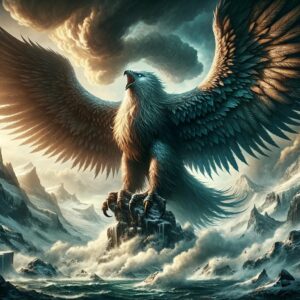
Abilities
Hraesvelgr’s abilities are deeply intertwined with the elemental forces of wind and air. He is the embodiment of the howling gales and tempestuous winds that sweep across the northern reaches of the Norse cosmos. Some of his notable abilities include:
Control over Winds: Furthermore, Hraesvelgr has the power to manipulate the winds, shaping them into fierce storms or gentle breezes. His ability to summon winds of such strength is so profound that they can significantly impact the course of ships and decisively determine the outcome of battles.
Weather Manipulation: As a master of the wind, Hraesvelgr can also control the weather. At will, he conjures thunderstorms, blizzards, and hurricanes, establishing himself as a formidable presence in the natural world.
Eagle Transformation: In one particularly intriguing myth, Hraesvelgr assumes the form of a giant eagle. In this guise, he perches atop the northern edges of the world, creating the winds through the powerful flaps of his wings. This transformation highlights his connection to the avian realm, where he shares characteristics with other mythical birds like the legendary roc or the thunderbird from other cultures.
Weaknesses
Despite his formidable powers, Hraesvelgr is not invincible. Like all beings in Norse mythology, he has his vulnerabilities:
- Vulnerability to the Gods: Moreover, Hraesvelgr, like all giants, is not immune to the machinations of the Norse gods. In several myths, the gods engage in conflicts with the giants, and Hraesvelgr is not exempt from their wrath.
- Fickle Nature: The wind giant’s actions can be unpredictable. Sometimes he may aid the gods, while at other times, he may cause havoc and chaos with his weather manipulation. This fickle nature makes it difficult to predict his intentions and behavior.
Behavior with Humans
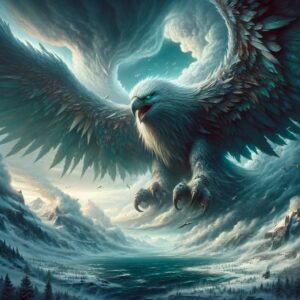
Hraesvelgr’s interactions with humans are infrequent but impactful. As a guardian of the northern edges of the world, his presence can greatly affect the lives of those who venture into his domain. Sailors, in particular, hold a mixture of reverence and fear for him, as he controls the winds that determine the success or failure of their voyages.
In some Norse sagas and legends, Hraesvelgr is depicted as a neutral force, neither benevolent nor malevolent. He simply exists, and humans must navigate their destinies within the scope of his power. This ambiguity reflects the unpredictable and uncontrollable nature of the natural world, which the Norse people respected and feared in equal measure.
Symbols
Symbols associated with Hraesvelgr are primarily drawn from the natural world and the elements he commands. Some of the key symbols representing him include:
- Eagle Symbolism: Hraesvelgr often associates with the image of a giant eagle, symbolizing his ability to transform into this majestic bird and perch at the world’s edge.
- Wind and Storm Symbols: Hraesvelgr uses symbols like swirling winds, thunderclouds, and tempests to master the weather and air forces.
- Northern Horizon: The northern horizon, where the sky meets the sea, is a symbolic representation of Hraesvelgr’s domain and presence in the Norse cosmos.
Related Myths and Stories
Hraesvelgr appears in several Norse myths and sagas, each highlighting different aspects of his character and abilities:
Ragnarök
During the apocalyptic event of Ragnarök, Hraesvelgr emerges as a pivotal and dramatic figure in Norse mythology. As this cataclysmic battle unfolds, Hraesvelgr takes on the formidable form of a giant eagle, playing a significant and ominous role in the ensuing chaos and destruction that engulfs the world.
Within the context of Ragnarök, Hraesvelgr’s transformation into a giant eagle symbolizes the culmination of the world’s cataclysmic fate. As the battle between the forces of chaos and order reaches its climax, his soaring flight becomes a foreboding presence in the sky, signifying impending doom. With wings that span the heavens, Hraesvelgr’s descent upon the battlefield becomes a harbinger of chaos and devastation, further intensifying the apocalyptic atmosphere.
Hraesvelgr’s involvement in Ragnarök highlights his link to the forces of nature and the impending dissolution of the familiar world. His presence in this pivotal event serves as a potent reminder of the profound and interconnected roles that mythical beings played in the Norse cosmology, as well as their symbolic representation of the natural forces that the Norse people held in awe and reverence.
The Poetic Edda

Within the Poetic Edda, a collection of Old Norse poems, there are notable mentions of Hraesvelgr in works like “Vafþrúðnismál” and “Grímnismál.” These verses offer valuable insights into his distinctive role as a guardian at the northern extremities of the world and his remarkable influence over the natural elements, particularly the weather.
In “Vafþrúðnismál,” Hraesvelgr’s presence is alluded to, highlighting his connection to the celestial boundaries where the sky meets the sea. This ethereal position underscores his pivotal role in the cosmos. The poem hints at his power and significance within Norse mythology.
Similarly, “Grímnismál” delves into Hraesvelgr’s role in greater detail. It portrays him as a sentinel at the world’s edge, perched in a vantage point where he commands a view of the vast expanse. From this lofty position, he exercises control over the weather, a responsibility that carries immense weight in Norse mythology. The verses emphasize his ability to conjure and manipulate thunderstorms, blizzards, and hurricanes, illustrating his formidable influence on the natural world.
Hrafnagaldr Óðins
In the Old Norse poem “Hrafnagaldr Óðins,” commonly referred to as the “Raven Song of Odin,” Hraesvelgr makes a significant appearance within the context of Odin’s relentless pursuit of wisdom and knowledge. This poem sheds further light on Hraesvelgr’s role in Norse mythology, particularly in relation to Odin’s quest.
Within the poem, Hraesvelgr is depicted as being intricately linked to the forces of the wind and the majestic eagle. This association underscores his elemental nature and his embodiment of the powerful natural phenomena that held great significance in the Norse world. Consequently, as Odin seeks wisdom and transcendent insight, the mention of Hraesvelgr serves as a symbol of the formidable challenges he faces on his path to enlightenment.
The presence of Hraesvelgr in “Hrafnagaldr Óðins” not only reinforces his position as a prominent figure in Norse mythology but also highlights the interconnectedness of various mythical beings and the intricate web of beliefs that defined this ancient culture. Hraesvelgr’s inclusion in this poem adds depth to the narrative of Odin’s quest, portraying him as an essential element in the cosmos and a potent symbol of the natural forces that the Norse people held in reverence.
Other Creatures
Roc: Furthermore, in Arabian and Persian mythology, the roc is a colossal bird of prey with the remarkable ability to carry away elephants. Much like Hraesvelgr, the roc stands as a symbol of immense power and mastery over the skies.
Thunderbird:Additionally, Native American folklore associates the thunderbird, a mythical creature, with storms and thunder. It shares some similarities with Hraesvelgr in its control over weather phenomena.
Simurgh: From Persian mythology, the Simurgh is a benevolent, wise, and powerful bird-like creature with the ability to heal. While it differs in nature from Hraesvelgr, it shares the motif of a giant bird with supernatural attributes.
FAQ
What is Hraesvelgrs role in Norse mythology?
Hraesvelgr is associated with the forces of nature, particularly the wind and the weather. He is said to reside at the northern edge of the world, where he influences the wind and controls the weather.
Is Hraesvelgr mentioned in any famous texts?
Yes, Hraesvelgr is mentioned in both the Poetic Edda and the Prose Edda, two important collections of Old Norse literature.
What is Hraesvelgr role in Ragnarök?
During Ragnarök, the apocalyptic event in Norse mythology, Hraesvelgr transforms into a giant eagle and contributes to the chaos and destruction of the world.
What does Hraesvelgr mean?
The name Hraesvelgr can be translated as "Corpse Swallower" or "Corpse Devourer," suggesting a fearsome and awe-inspiring nature.
Is there any connection between Hraesvelgr and other mythological creatures?
In Native American folklore, there are similarities between Hraesvelgr and the thunderbird, as both are associated with controlling weather phenomena.
